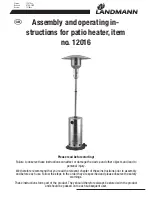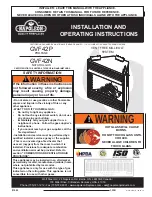
9
wait for the water within it to cool down, close the main tap and let the water flow
out of the appliance through the inlet pipe after having opened the drain tap as well
as a hot water tap.
Unscrew the 5 bolts (C fig. 10) and remove the flange (F fig. 11). The heating element
and the anode are connected to the flange. When reassembling, make sure that the
position of the flange gasket, of the thermostat and of the heating element are the
original ones (fig. 10). After each removal, we advise you to replace the flange gasket
(Z fig. 12).
Make sure you respect the polarity of the electrical connections as in (fig. 10) and
(fig. 13).
Periodical maintenance
For a good and efficient output of your appliance, you should remove the limescale built
up on the heating element (R fig. 12) about every two years. This operation should be
carried out on the dismounted heating element and, if you do not want to use purpose-
made acids, this can be done by breaking up the calcareous incrustation, taking care
not to damage the protective layer of the heating element. To guarantee the long life
of your appliance, the magnesium anode (N fig. 12) must be replaced every other
year. To remove it, take out the heating element and unscrew it from the supporting
bracket.
Bipolar safety device
In the event of abnormal overheating of the water, a thermal safety switch, complying
with CEI-EN regulations, shuts off the electric circuit on both the phases supplying the
heating element; in this case, call for Technical Assistance.
Safety valve
In those models equipped with a safety valve with a lever, the latter can be used, by
lifting it up, to:
- empty out the appliance, if necessary,
- check on a regular basis (every month) that the valve is operating correctly.
Handy tips
Upon heating, you may hear some normal sounds within the water heater that are due
to the heat exchange between the heating element and the water touching it. If hot
water does not come out of the utilisation taps, check that the water and electricity
connections have been carried out as specified in the corresponding paragraphs, or
after having dismounted the thermostat, check the continuity of the phases between
the terminals and the relative fastons. If this is not the case, the bipolar safety device
could have come into operation (see the paragraph on periodical maintenance). Should
the appliance heat the water up, but the pilot lamp does not light up, the failure could
simply be due to this specific part. For the water heater's galvanic protection system
to function properly, the permanent hardness of the water should not be less than 12
°
French hardness degrees. During the normal functioning of the appliance, the water
connections could become hot.
GB
Summary of Contents for 869428
Page 43: ...42 RUS ...
Page 44: ...43 RUS ...
Page 45: ...44 RUS ...
Page 46: ...RUS 45 ...
Page 48: ...47 UA ...
Page 49: ...48 UA ...
Page 50: ...49 UA ...
Page 51: ...50 UA ...
Page 53: ...52 LT ...
Page 54: ...53 LT ...
Page 55: ...54 LT ...
Page 56: ...55 LT ...
Page 58: ...57 LV ...
Page 59: ...58 LV ...
Page 60: ...59 LV ...
Page 61: ...60 LV ...
Page 63: ...62 EE ...
Page 64: ...63 EE ...
Page 65: ...64 EE ...
Page 66: ...65 EE ...
Page 68: ...67 KZ ...
Page 69: ...68 KZ ...
Page 70: ...69 KZ ...
Page 71: ...70 TR 1 ...
Page 72: ...71 TR ...
Page 73: ...72 TR ...
Page 74: ...73 TR ...
Page 76: ......
Page 77: ......
Page 78: ......











































